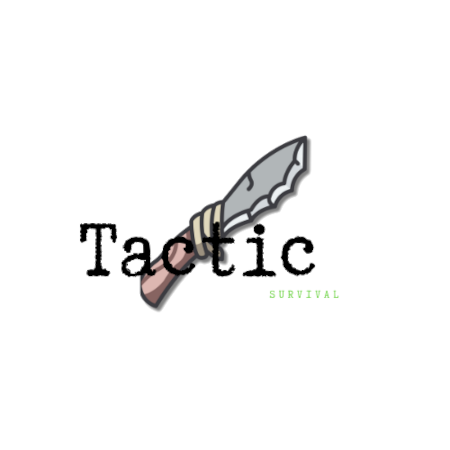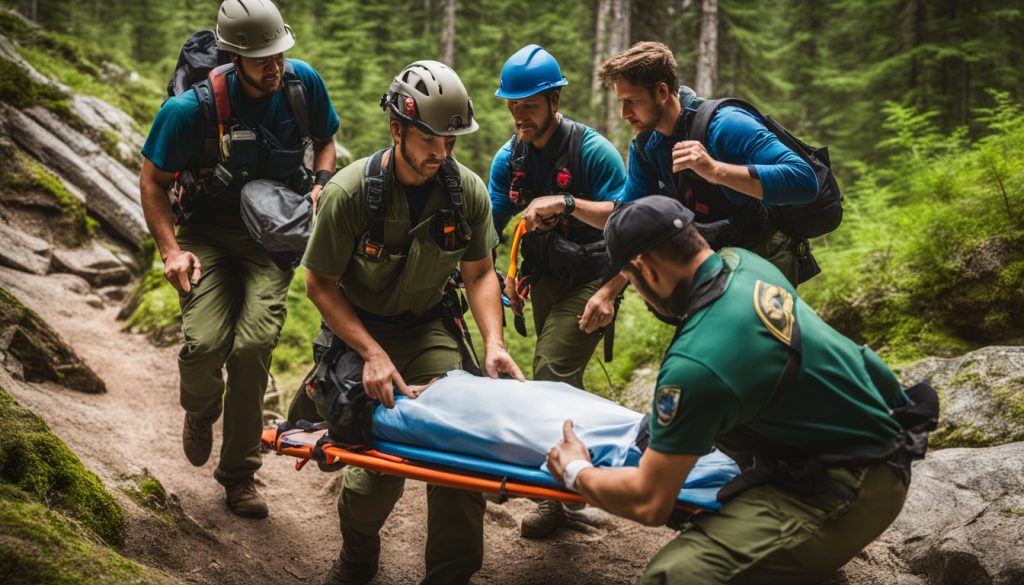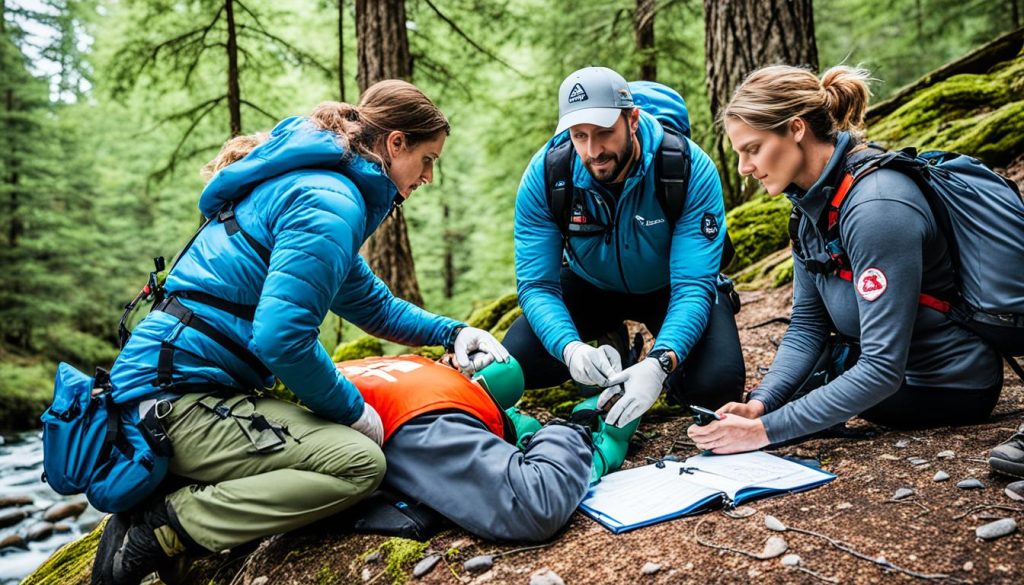Access to medical care can be hard to get when you’re in the wild. Sometimes, it’s just not around. In these cases, Wilderness First Responder (WFR) courses can be a lifesaver.
WFR classes teach you everything about helping in the wild. You learn how to do check-ups and give first aid. This knowledge is key for anyone who loves the outdoors or works in it.
If you’re into the wild, work as a guide, or help with rescues, you need this. WFR courses are a must for dealing with medical emergencies in far-off places.
Key Takeaways:
- Wilderness First Responder (WFR) certification courses provide comprehensive training in wilderness medicine.
- These courses equip participants with the skills to handle emergency situations in remote and wilderness settings.
- WFR certification is essential for outdoor enthusiasts, outdoor educators, wilderness guides, and search and rescue team members.
- Access to timely medical care can be unreliable in backcountry environments, making WFR training crucial for wilderness safety.
- The WFR certification prepares individuals to perform physical examinations, administer emergency treatments, and manage injuries in challenging settings.
Duration and Tuition
The Wilderness First Responder course is made for those working in far-off or wild places. These are areas where getting medical help quickly is hard. The course takes 9-10 days. This adds up to around 80 hours of learning time.
The cost to join the Wilderness First Responder course can vary. It usually falls between $775 and $1,700. You get a lot from this, such as hands-on training and guidance from experts in the field.
There are ways to get help paying for this course, like scholarships. These can make it easier for people from all walks of life to get their WFR certification. Financial help is there so that anyone really wanting this can join.
The WFR certification is very valuable in outdoor work. It gives you the skills to help in emergencies. With top-notch teaching and lots of things to learn, this course is a great choice for anyone wanting to boost their wilderness medicine skills.
Testimonials
“I just finished the Wilderness First Responder course. It was so valuable. I learned a lot about wilderness medicine. The cost was worth it for everything I learned. I think it’s a must for anyone who loves being outdoors.”
“I loved the Wilderness First Responder course. It was more than I hoped for. I learned a ton about helping in the wild. Now I feel ready for anything. I say go for it, for sure!”
Course Curriculum
This course aims to teach folks how to give first aid in the wild. It covers many topics on wilderness medicine. People will be ready to act in different medical emergencies.
Response and Assessment
Students will figure out how to check and rank medical problems outside. They will learn to look at patients fast and right. This helps them choose the best treatment and when to get help.
Musculoskeletal Injuries
How to handle bone and muscle injuries is a big part of the course. Participants learn to set and support breaks and tears. They also practice using things you find to make splints when there are no supplies.
Environmental Emergencies
Knowing and reacting to problems like heat stroke, cold, mountain sickness, and getting hit by lightning are crucial. People will learn how to stop these issues. And, they’ll know how to help if they happen.
Survival Skills
Survival is key in the wilderness. The course teaches how to build shelters, manage fires, purify water, and navigate. By the end, students will feel ready to make it and help others in wild places.
Soft Tissue Injuries
Handling cuts, scrapes, and burns gets a lot of focus. People will learn to clean, cover, and protect these injuries. Using things from nature for wound care will also be covered.
Medical Emergencies
Knowing what to do in common health crises outdoors is important. This includes heart, breathing, allergy, and diabetic problems. Students will be ready to help keep people stable until they get professional care or can leave the area.
This curriculum is carefully crafted for wild medical emergencies. It gives people the know-how and skills they need. By going over lots of topics, students are set to handle almost any health problem in the wilderness. They’ll know what to do.
Hybrid Format and Accessibility
Providers of Wilderness First Responder (WFR) certification courses see more demand. To meet a wider group, they’ve introduced a hybrid course. It mixes online learning with hands-on in-person experience.
The hybrid model is perfect for those wanting flexibility. It lets students go at their own pace. The online part covers theory such as medical response and injuries for 30-40 hours.
This means you can learn from anywhere, fitting well with busy lives or distant locations. It’s perfect for those who can’t always be at physical training centers. The self-paced style guarantees you understand each part before moving forward.
In-person sessions are 5 day-long and full of practical scenarios. Led by pros, you’ll learn how to react in real wilderness emergencies. It’s a boost for your confidence in handling remote areas.
This format is also a great leveling field. It saves you from long travels and brings together people from various fields. So, you could be into outdoors, teach, lead scouts, or do search and rescue. Everyone is welcomed.
The blend of online and in-person means you get a deep and broad study in wilderness medicine. You’ll be ready to step up in backcountry emergencies. And you can, all thanks to this smart mix.
Quotes:
“The hybrid format of the Wilderness First Responder course is a game-changer. It allowed me to complete the theoretical portion at my own pace and then apply what I learned in realistic scenarios during the in-person sessions. It’s the perfect blend of convenience and hands-on training.” – Emily Thompson, Outdoor Educator
| Benefits of the Hybrid Format | Access to Training | Flexibility and Convenience | Realistic Hands-on Experience |
|---|---|---|---|
| 1. Comprehensive training combining online and in-person components | 1. Overcome geographical limitations | 1. Learn at your own pace | 1. Practice skills in realistic scenarios |
| 2. Suitable for individuals from diverse backgrounds and professions | 2. Ideal for those with limited access to training centers | 2. Fit learning around busy schedules | 2. Gain confidence in emergency response |
| 3. Offers a balance between convenience and hands-on experience | 3. Accessible for remote or rural communities | 3. Conveniently access online content from anywhere | 3. Learn decision-making under pressure |
Certification and Continuing Education
When you finish the Wilderness First Responder course, you get a WFR certification. This prestigious prize shows you know how to care for others in the wilderness. It’s accepted by many across the country.
The certification lasts for three years. During this time, you’ll keep learning about the newest wilderness medical methods.
This course is also great for EMTs and healthcare pros looking to improve their wilderness care. With 70 EMT Continuing Education Hours by CAPCE, it helps you get ahead in your career.
It lets you earn credits towards becoming a Fellow of the Academy of Wilderness Medicine (FAWM) too. This can really help if you want to advance in wilderness medicine work.
For students, you can get 3 college credits from the University of Utah and Western Colorado University. This recognition makes your certification even more valuable.
Important groups like the American Camp Association and the Boy Scouts of America approve of this course. It meets the top standards for training in wilderness activities.
It’s also good for anyone looking for first aid and CPR training, like the Coast Guard requires. This shows how useful and up-to-date the course is for many outdoor fans and pros.
Continuing Education Opportunities
The Wilderness First Responder course opens many doors, not just with a certificate. It offers ways to keep learning and growing in wilderness medicine.
| Opportunity | Description |
|---|---|
| EMT Continuing Education Hours (CAPCE) | It gives you 70 hours of EMT Continuing Education Hours. This keeps your skills fresh and in line with the latest in wilderness medicine. |
| Fellowship of the Academy of Wilderness Medicine (FAWM) Credits | Completing the course earns you credits towards the FAWM, showing your dedication to top-quality wilderness medicine. |
| College Credits | You can earn 3 college credits from the University of Utah and Western Colorado University. It recognizes your expertise academically. |
The Wilderness First Responder course does more than teach wilderness first aid. It helps you keep growing and learning in this area. For a career or personal interest, this course offers valuable ways to keep getting better in wilderness medicine.
Course Policies and Additional Details
Before joining the Wilderness First Responder (WFR) certification course, it’s crucial to know the policies. These include rules on canceling, how often you need to be there, and the age you must be to participate. Knowing these policies ensures everyone has a great learning experience.
Course Policies
- Cancellation Policies: Understand what happens if you need to cancel. Check what deadlines exist for refunds or penalties. It’s smart to look at these before signing up.
- Attendance Requirements: To pass the WFR course, you usually have to be at every session. Make sure you can be there for all lessons and activities.
- Minimum Age Requirements: Some courses have an age limit for joining. Be sure to double-check this before you sign up.
Academic Credit and Standards
This course might earn you college credits with certain universities. It’s a great way to add to your academic and work profile in wilderness medicine.
It meets the standards of groups like the American Camp Association and Boy Scouts of America. This ensures you learn the latest and best practices in the field.
Additional Certifications and Qualifications
Finishing the course gives the WFR certification. You might also get other qualifications, like credits toward Fellowship of the Academy of Wilderness Medicine (FAWM). It shows your deep knowledge in wilderness medicine.
Knowing the course policies and details helps you choose wisely and be fully involved in the Wilderness First Responder course. These facts lay the groundwork for a rewarding learning journey. They also prove the course providers’ dedication to offering top-tier wilderness medicine training.
Conclusion
Wilderness First Responder courses are key for those in outdoor work. They give in-depth training in wilderness medicine. Completing these classes is crucial for wilderness guides, trip leaders, and search and rescue teams.
Participants understand how to respond in the wilderness. They learn about injuries, survival, and medical issues. With this knowledge, they can deal with emergencies effectively. This is vital in unpredictable outdoor areas.
Completing the certification offers more than medical knowledge. It allows for further professional growth. This can include earning more education credits or pursuing higher qualifications, like the Fellowship of the Academy of Wilderness Medicine (FAWM) credits.


